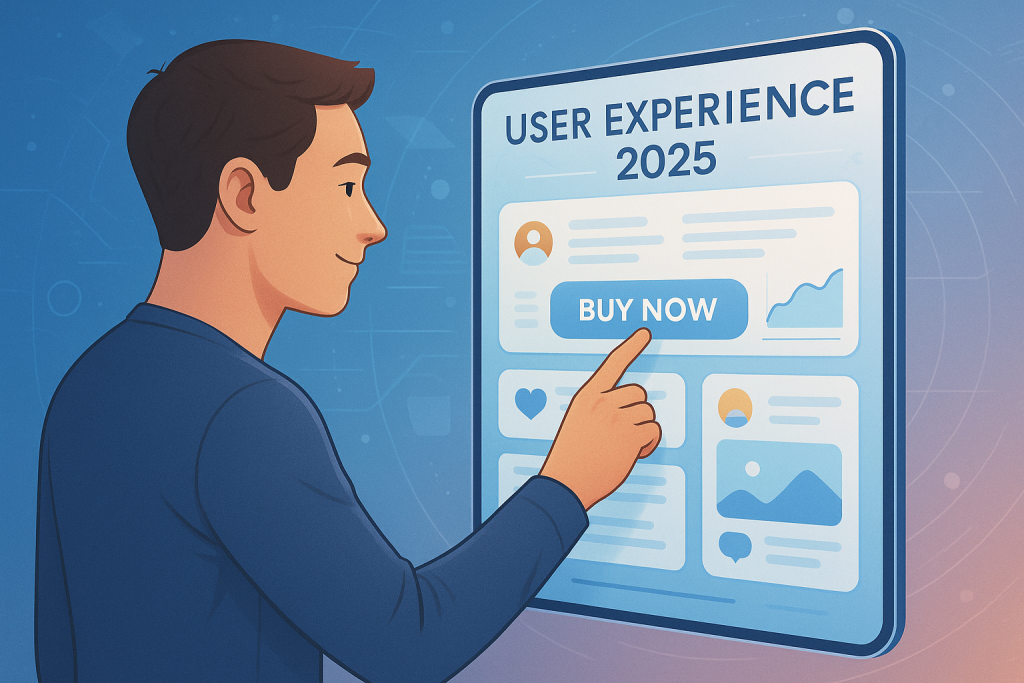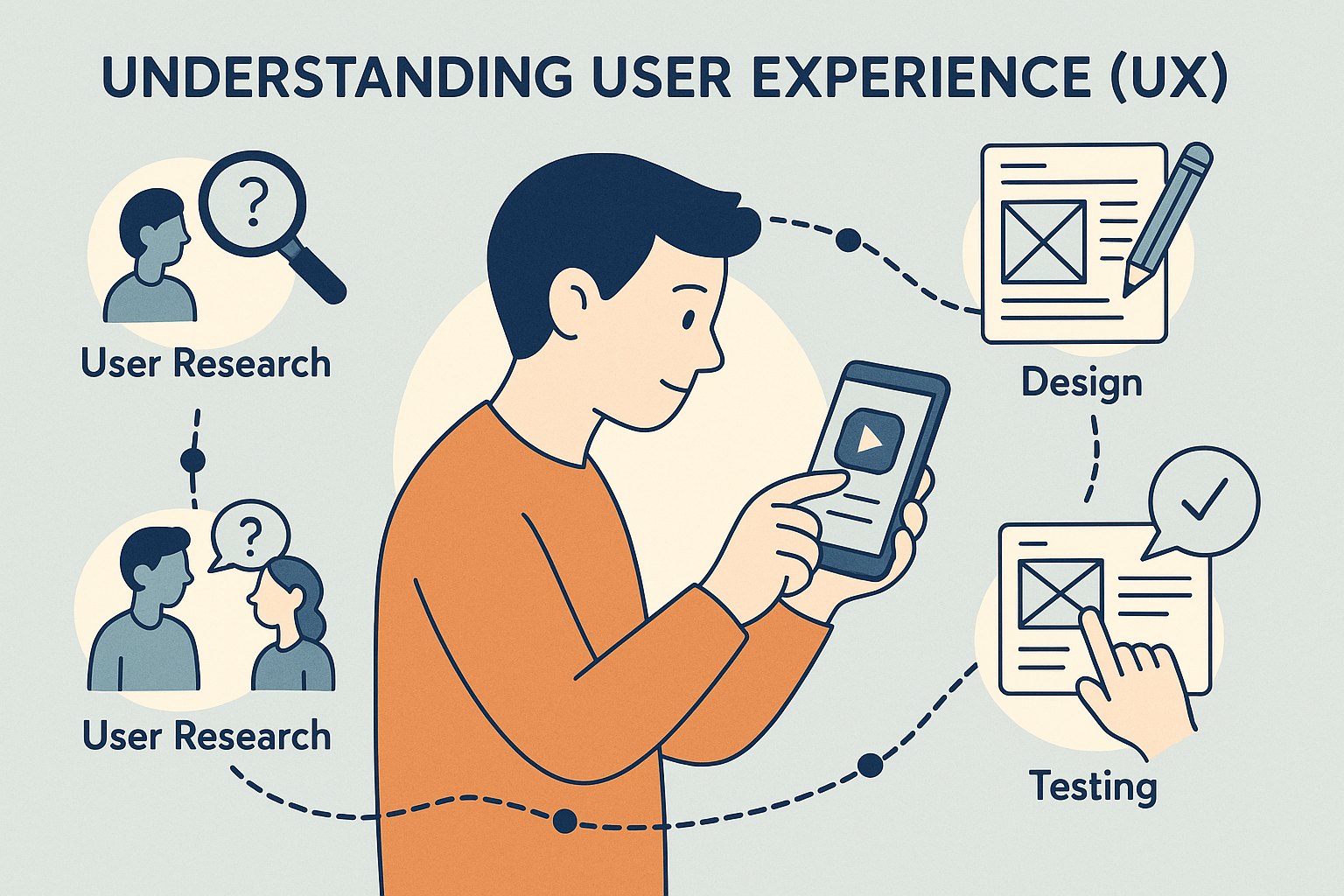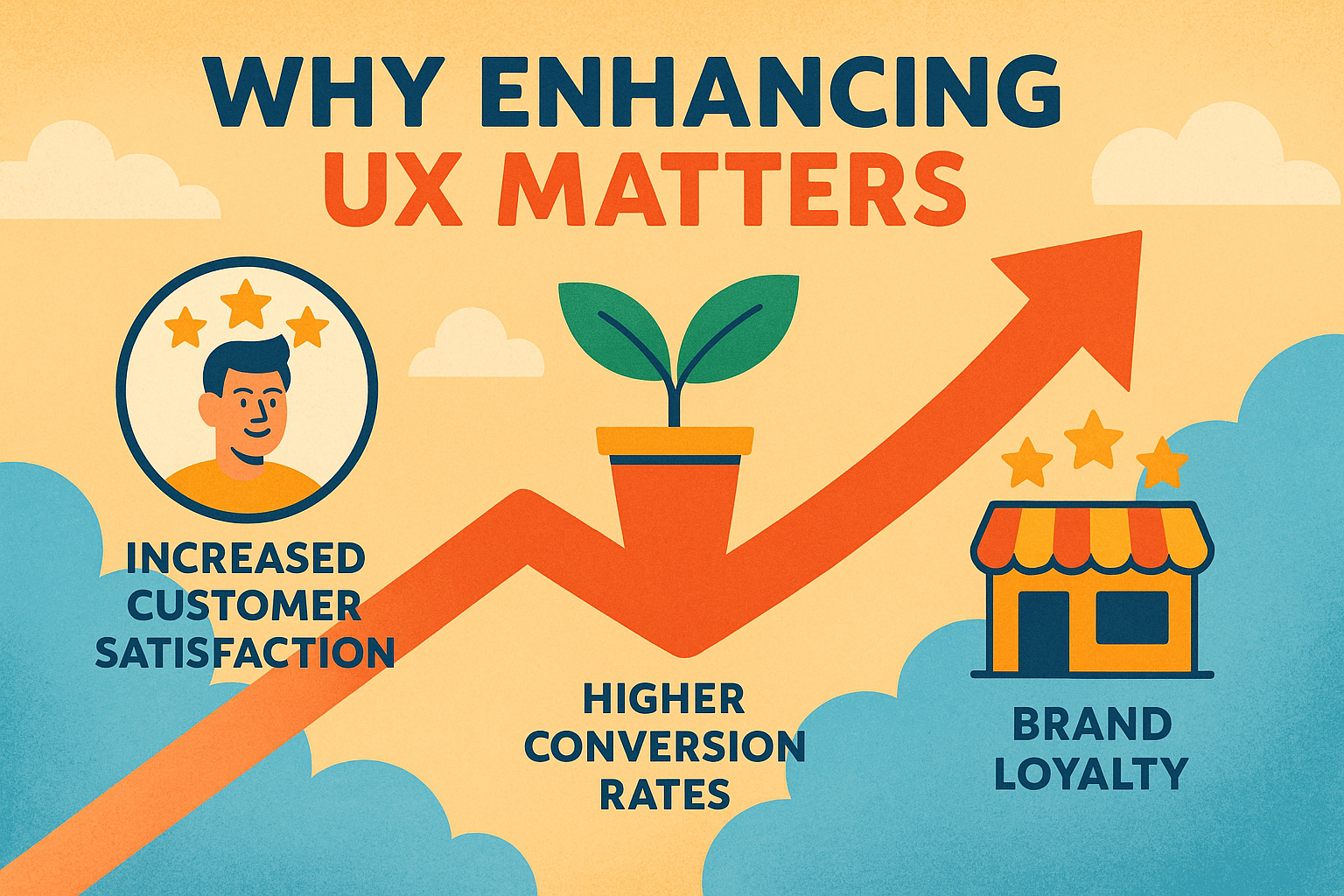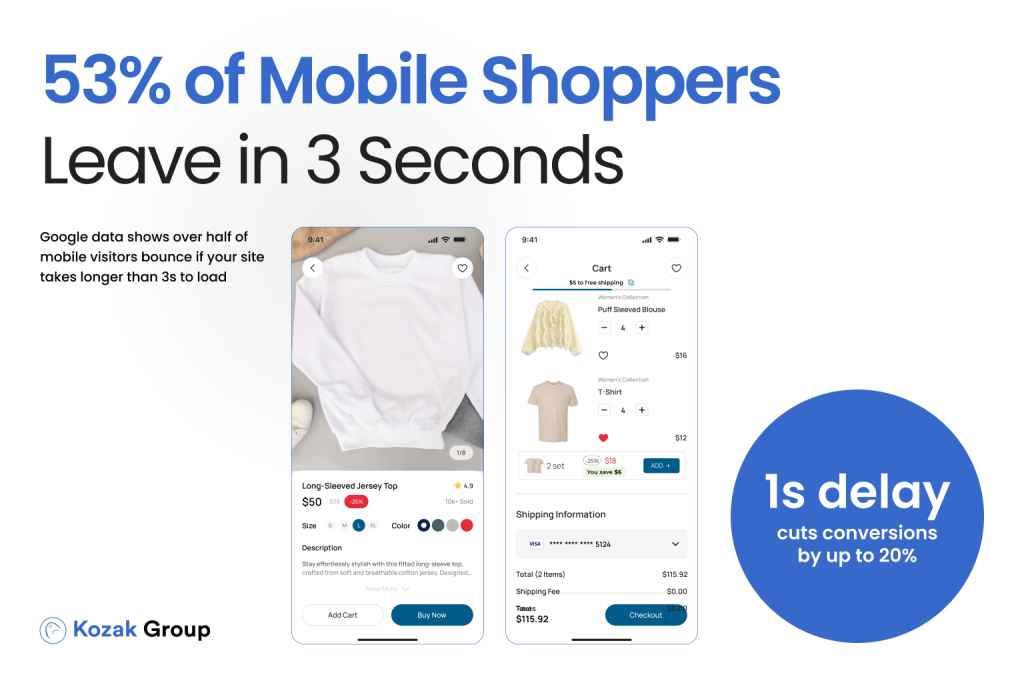User experience enhancement is essential for staying competitive in 2025. As user expectations and technology evolve, improving the way users interact with your product is key, especially when focusing on the needs and satisfaction of the end user. This article covers 10 actionable tactics to improve user experience, helping you ensure satisfaction and loyalty.
Key Takeaways
- User experience (UX) is crucial for ensuring ease of use and satisfaction in digital products, and a website’s user experience directly impacts customer loyalty and conversion rates.
- Conducting thorough user research and data analysis helps identify user pain points, guiding effective UX improvements and ensuring designs meet user needs.
- Prioritizing mobile responsiveness, navigation design, and proactive customer support, along with optimizing website’s performance, are essential strategies for enhancing overall user experience and driving business success.
Understanding User Experience (UX)
User experience (UX) is the backbone of any digital product. It encompasses how users interact with a product or service, focusing on the user’s interaction and their overall perceptions of those interactions. At its core, UX aims to fulfill user needs by ensuring that products are easy to use, efficient, and enjoyable, leading to improved customer satisfaction and loyalty. This multidisciplinary field of user experience design combines principles from design, psychology, and engineering to create intuitive user experiences that resonate with users, enhancing the user’s experience.
Effective UX design goes beyond aesthetics; it prioritizes the functional flow of user interactions and the emotional satisfaction derived from those interactions. A user-centered design approach, championed by Don Norman, ensures that every design decision is made with the user’s needs and vocabulary in mind, aligning design elements and language to improve usability. This approach not only enhances the user journey but also contributes to a positive user experience, which is crucial for turning visitors into loyal customers. Additionally, effective ui design plays a significant role in achieving these goals, especially when implemented by skilled ux designers.
Consistency in UX design helps users navigate the user interface without having to relearn the layout and functions repeatedly. Meaningful and consistent experiences can significantly boost conversion rates and strengthen a business’s online presence.
Why Enhancing UX Matters
In today’s competitive markets, enhancing user experience is more critical than ever. Companies that prioritize UX can differentiate themselves by providing more user-friendly and intuitive interactions, fostering trust and credibility among their customers. A well-optimized UX not only builds brand loyalty but also directly impacts business revenue by driving higher conversion rates. Additionally, improving UX can enhance your website’s visibility in search engines, as search engines favor sites with better performance and usability.
Simple navigation and clear calls to action are essential elements of a strong UX, making it easier for users to complete desired actions and improving overall user satisfaction. Moreover, businesses that invest in user-friendly designs often see a significant reduction in customer support needs, as users can navigate, including through keyboard navigation, and troubleshoot key tasks independently.
Conducting User Research
Conducting thorough user research is the foundation of any successful UX strategy. It involves gathering insights into user behaviors, motivations, and pain points through various methods such as contextual inquiry, user interviews, focus groups, and qualitative market research. To conduct user research effectively, direct user engagement uncovers emotional and practical challenges that quantitative data alone might not reveal.
Utilizing multiple user research methods, such as surveys, interviews, focus groups, and web analytics, provides a comprehensive understanding of user needs and various aspects for improvement through a consultative approach. This diverse approach ensures that insights are well-rounded and actionable, leading to more effective UX improvements.
Once user research is conducted, it’s crucial to revisit and update user personas based on the gathered insights. Triggering microsurveys at critical touchpoints can provide real-time feedback, helping to refine user personas and ensure they reflect the current user base’s needs and trends.
Identifying Pain Points Through Data Analysis
Identifying user pain points is a critical step in improving UX, and data analysis plays a pivotal role in this process. Quantitative data analysis helps pinpoint inherent pain points and provides a basis for UX design improvements. Analyzing product data reveals user interactions, drop-off points, and ignored features that may indicate usability issues.
Various methods can help identify and address these pain points:
- Heatmaps: Visually represent user interactions, highlighting confusing or neglected areas of a webpage.
- Funnel analysis: Pinpoints friction points in the user journey, enabling timely interventions.
- The Five Whys technique: Delves into the root causes of user frustrations by repeatedly asking ‘why’.
Creating User Personas
User personas are fictional profiles that represent specific segments of the target audience, helping to understand their unique needs, motivations, and frustrations. Creating detailed personas involves gathering actual data and insights through user research, ensuring that they accurately reflect the user base.
Empathy mapping is a valuable tool in this process, enabling designers to delve into users’ emotional experiences and uncover deeper frustrations. Regularly updating user personas is essential to keep them relevant and aligned with changing user needs and trends.
Creating user journey maps can further enhance the understanding of where users encounter obstacles. These visual representations highlight key touchpoints and help identify areas for improvement, ultimately leading to a more seamless and satisfying user journey.
Optimizing Navigation Design
Optimizing navigation design is crucial for enabling users to find information efficiently and intuitively. A well-structured navigation system helps users locate what they need quickly, enhancing their overall experience. Consistent navigation design across all pages minimizes cognitive load, allowing users to focus on their tasks without unnecessary distractions, which is a key aspect of information architecture.
Exploring different navigation options with real users can lead to better design decisions. Techniques such as:
- Sticky navigation
- Dropdown menus
- Breadcrumb navigation can effectively organize content and keep important menu options easily accessible, ensuring a smooth user flow. Additionally, using text links as secondary or tertiary call-to-action elements provides supplementary navigation without cluttering the interface, helping users access less prominent actions or assistance.
Enhancing Mobile Responsiveness
With over 60% of web traffic originating from mobile devices, enhancing mobile responsiveness is essential for a positive user experience. A responsive design ensures that website content automatically reorganizes itself to optimize the viewing experience across various screen sizes, providing accessibility for all users.
Adopting a mobile-first approach is crucial, as users frequently switch devices during their customer journey. Designing for mobile devices first ensures that the user experience is seamless and consistent, regardless of the device used. In addition to websites, optimizing mobile apps for usability and performance is equally important, as dedicated mobile apps require specialized tools, testing methods, and analytics to enhance user experience.
Focusing on mobile responsiveness improves user satisfaction and search engine optimization for website users’ performance while improving user experience. It is essential to respond quickly to their needs.
Implementing Usability Testing
Usability testing is a vital component of UX optimization, as it helps analyze how users interact with an interface and identify areas for improvement. Understanding who the users are and their device usage is the first step in this process. To conduct usability testing allows users to perform tasks while providing feedback, revealing usability issues that may not be immediately apparent.
A/B testing is a useful technique for comparing different versions of an interface. It helps identify which version performs better. Continuous testing is essential for refining interface layouts and enhancing the in-app experience for users.
User Acceptance Testing (UAT) involves real users performing specific tasks to provide crucial user’s feedback for design adjustments, enhancing user interaction with actual users through user testing as the user interacts.
Utilizing Visual Design Elements
Visual design is perhaps the most overt aspect of user experience, heavily influencing first impressions. Effective visual design aligns with usability principles to ensure a pleasant and intuitive user experience. User interface design plays a crucial role in creating aesthetically pleasing interfaces that enhance user engagement through interaction design.
Color schemes and white space are important elements of visual design:
- High contrast aids in readability and helps users navigate content more easily.
- White space prevents information overload and confusion.
- Consistency in visual elements across different screens helps users recognize interactive components, contributing to a cohesive user experience and color scheme.
Visual design decisions are typically made at later stages in the design process, following foundational UX considerations. Contextual and informative visuals should be used to enhance user engagement and ensure a seamless experience, allowing designers to make informed decisions.
Providing Proactive Customer Support
Proactive customer support involves anticipating and addressing potential issues before users need assistance, leading to improved customer satisfaction. An in-app resource center provides self-service support, allowing users to resolve issues quickly without waiting for assistance from the customer support team.
Using product usage analytics can reveal underused features and areas where potential customers may need additional support, such as during the online purchase process. We can identify opportunities to provide guidance and helpful content that enhances the customer experience and builds positive interactions with users, including technical information.
Avoiding Information Overload
Avoiding information overload is essential for creating a positive user experience. When users interact with a website or application, they should be guided through their user journey with clarity and purpose. Overwhelming users with excessive content, dense layouts, or too many options can quickly lead to confusion and frustration, detracting from user engagement and satisfaction.
To prevent this, it’s important to conduct user research and develop detailed user personas that reflect the needs and preferences of your target audience. By understanding what information is most valuable to users, designers can prioritize key content and eliminate unnecessary distractions. Techniques such as strategic use of white space, clear typography, and intuitive navigation help users find what they need quickly and effortlessly. This approach not only streamlines the user journey but also ensures that users interact with your website in a way that feels natural and stress-free, ultimately fostering a more positive user experience.
Best Practices for UX Enhancement
Adopting best practices for UX enhancement is crucial for delivering a seamless and enjoyable experience to your users. Start by focusing on user interface design—ensure that every element is intuitive, visually appealing, and accessible to all users. Regular user testing and gathering user feedback are vital steps in identifying pain points and uncovering areas for improvement. This iterative process allows you to refine the user interface based on real-world interactions.
Given that most users interact with websites and applications on their mobile devices, mobile optimization should be a top priority. Responsive design, touch-friendly elements, and fast load times all contribute to a superior mobile experience. Additionally, integrating usability testing into your workflow helps validate design decisions and ensures that the website meets user expectations.
Don’t overlook the importance of search engine optimization (SEO) in your UX strategy. A well-structured, accessible website not only improves user experience but also boosts visibility in search engine rankings, attracting more potential users. By following these best practices, you can enhance customer satisfaction, increase conversion rates, and drive sustainable growth for your business.
Optimization Strategies for Continuous Improvement
Continuous improvement in user experience requires a proactive and data-driven approach. Begin by conducting ongoing user research and regular usability testing to gather actionable insights into how users engage with your website. User testing sessions, combined with user feedback, help identify areas where UX improvements are needed most.
A/B testing and experimentation are powerful tools for determining which design elements—such as color schemes, typography, or calls-to-action—resonate best with your audience. Analyzing quantitative data, including website analytics and user engagement metrics, provides a deeper understanding of user behavior and highlights opportunities for optimization.
Collaboration is key: adopt a consultative approach by involving stakeholders throughout the process to ensure that UX enhancements align with broader business goals. By prioritizing user needs and leveraging data-driven insights, you can achieve positive results, improve customer satisfaction, and create a website that evolves alongside your users’ expectations.
Emerging Trends in User Experience
The landscape of user experience is rapidly evolving, with several emerging trends shaping how users interact with digital products. Accessibility is becoming a top priority, ensuring that websites and applications are usable by everyone, regardless of ability. Artificial intelligence is also transforming user experience, with AI-powered chatbots and virtual assistants providing instant support and personalized guidance to users.
Voice-activated interfaces are gaining traction, especially as smart speakers and voice assistants become more prevalent. Designing for voice requires a fresh approach to user interaction and interface design, focusing on natural language and conversational flows. These innovations are raising the bar for what users expect from their digital experiences.
By staying informed about these trends and understanding the needs of your target audience, you can create user experiences that are not only current but also forward-thinking. Embracing new technologies and design paradigms will help your business stand out and deliver exceptional value to users.
The Future of User Experience Enhancement
Looking ahead, the future of user experience enhancement is all about creating immersive, interactive, and highly personalized experiences. As technologies like augmented reality, virtual reality, and the Internet of Things (IoT) become more mainstream, designers will have new opportunities to blur the lines between physical and digital environments, offering users experiences that are both engaging and memorable.
To thrive in this future, businesses must continue to prioritize user research and usability testing, ensuring that every aspect of their UX design is informed by the needs and preferences of their target audience. Continuous iteration and a commitment to understanding user needs will be essential for creating positive user experiences that drive customer satisfaction and loyalty.
By embracing innovation and maintaining a user-centered approach, organizations can create digital products that not only meet but exceed user expectations—ultimately leading to greater business success and a lasting competitive advantage.
Measuring UX Success
Measuring UX success is essential to ensure that UX improvements are effective and aligned with business goals. Collecting user feedback immediately after significant interactions provides valuable insights into areas needing improvement and successful features. Behavioral metrics, such as task completion times and abandonment rates, reveal what actions users take within the product.
Performance metrics, including task success rate and average session duration, highlight the speed and success rate of user interactions, indicating how effectively users can complete tasks. The Net Promoter Score (NPS) assesses overall user satisfaction by asking how likely users are to recommend the product, providing a clear measure of user loyalty.
A strong focus on UX can significantly improve user retention, business outcomes, and brand reputation. By continuously measuring and optimizing UX, businesses can achieve positive results and maintain a competitive edge in the market.
Summary
In summary, enhancing user experience in 2025 requires a comprehensive approach that includes understanding UX fundamentals, conducting thorough user research, identifying pain points through data analysis, and creating detailed user personas. Optimizing navigation design, enhancing mobile responsiveness, implementing usability testing, utilizing visual design elements, providing proactive customer support, and ensuring compliance with accessibility standards are all critical tactics for creating exceptional and inclusive digital experiences.
By measuring UX success through various metrics and continuously optimizing the user experience, businesses can achieve improved customer satisfaction, higher conversion rates, and a stronger brand presence. Embrace these tactics to stay ahead in the competitive digital landscape and deliver seamless, engaging experiences for your users.
Frequently Asked Questions
Why is user experience important for businesses?
User experience is essential for businesses because it significantly impacts customer satisfaction, brand loyalty, and conversion rates. A positive UX can set a business apart in competitive markets, ultimately driving higher revenue and customer retention.
What are some common methods for conducting user research?
To effectively conduct user research, consider using methods such as user interviews, surveys, contextual inquiry, and web analytics analysis. Combining these approaches will give you a well-rounded insight into user needs and challenges.
How can data analysis help in identifying user pain points?
Data analysis is crucial for identifying user pain points as it highlights user interactions, drop-off points, and overlooked features. By employing techniques like heatmaps and funnel analysis, you can uncover usability issues and understand the root causes of user frustrations.
What is the role of user personas in UX design?
User personas play a crucial role in UX design by representing specific segments of the target audience, which aids designers in understanding user needs, motivations, and behaviors. By using data-driven personas, designs become more user-centered and effective.
How can businesses measure the success of their UX improvements?
To effectively measure the success of UX improvements, businesses should leverage user feedback, behavioral metrics, performance metrics, and Net Promoter Score (NPS). These insights illuminate user satisfaction and engagement, guiding further UX optimization.









